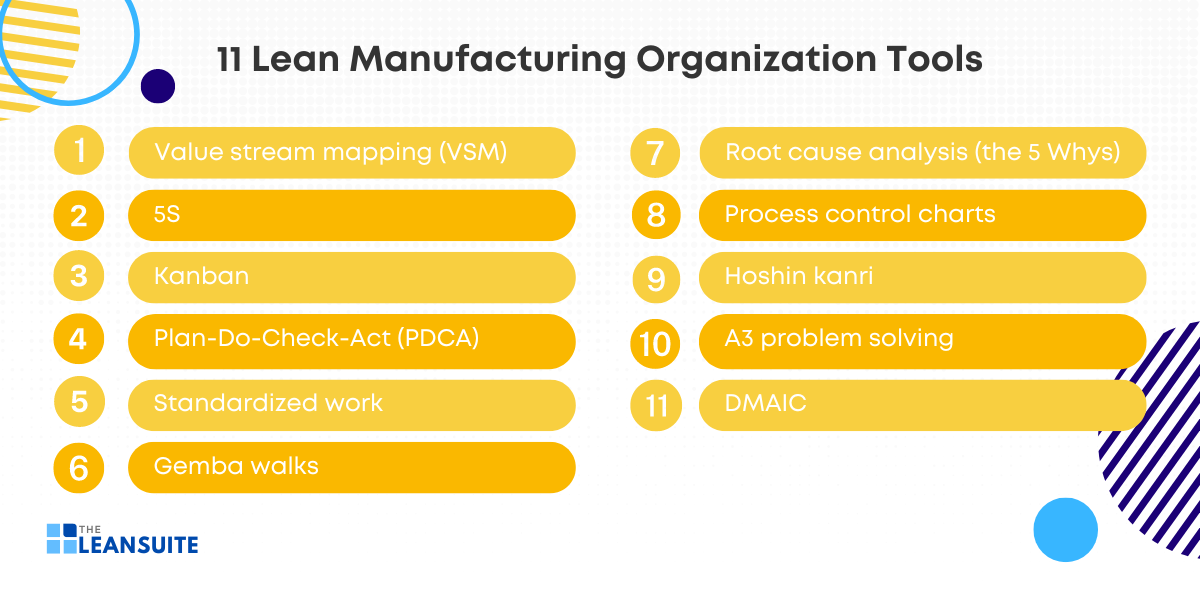In manufacturing, every second counts, and every process matters. That’s why implementing effective Lean manufacturing tools can be the game-changer your company needs to streamline operations, enhance productivity, and reduce waste. By embracing these innovative strategies, organizations can transform their workflows, ensuring that every resource is utilized to its fullest potential. In this blog post, we’ll explore the top 11 Lean manufacturing organization tools that can propel your business towards unparalleled efficiency and success.
What is Lean manufacturing?
Lean manufacturing, or Lean process management, is a systematic method for minimizing waste within a manufacturing system while simultaneously maximizing productivity. In essence, it is centered around the idea of preserving value with less work. The goal of Lean manufacturing is to increase efficiency and reduce costs by identifying and eliminating non-value-added activities — commonly referred to as “waste.”
The concept of Lean manufacturing originated from the Toyota Production System (TPS) in Japan. After World War II, Toyota, under the leadership of engineers like Taiichi Ohno and Eiji Toyoda, developed a new approach to manufacturing that focused on efficiency, quality, and continuous improvement. This system emphasized the importance of eliminating waste (known as “muda” in Japanese), optimizing workflow, and integrating a culture of continuous improvement (Kaizen).
The Lean methodology has since been adopted and adapted by various industries worldwide, beyond automotive manufacturing, due to its effectiveness in improving efficiency and reducing waste.
The five key principles of Lean manufacturing

Central to Lean manufacturing are the Lean manufacturing principles, which guide the systematic approach to minimizing waste and maximizing productivity. They are:
- Identify value: Define what adds value from the customer’s perspective.
- Map the value stream: Map out all steps in the value stream and identify and eliminate steps that do not create value.
- Create flow: Ensure that the remaining value-creating steps flow smoothly without interruptions, promoting continuous flow throughout the production process.
- Establish pull: Produce only what is needed by the customer, avoiding overproduction.
- Seek perfection: Continuously strive for perfection by improving processes and eliminating waste.
The 8 types of Lean manufacturing waste
Lean manufacturing identifies eight types of waste, often summarized by the acronym DOWNTIME. These wastes, collectively known as Muda from the Toyota 3M model, represent activities that do not add value to the product or service.
Understanding and addressing these wastes is crucial for enhancing productivity, reducing costs, and improving overall operational efficiency. Let’s explore each type of waste to see how they impact manufacturing processes.
- Defects
- Definition: Products or services that do not meet quality standards or customer expectations.
- Impact: Defects lead to rework, repairs, or even scrapping of products, which consumes time and materials, and can damage customer satisfaction and trust.
- Example: A car with a faulty brake system that needs to be recalled.
- Overproduction
- Definition: Producing more than is needed or producing too soon.
- Impact: Overproduction ties up resources, increases inventory costs, and can lead to excess waste if products become obsolete.
- Example: Manufacturing 1,000 units when there is only demand for 500.
- Waiting
- Definition: Idle time when resources (materials, information, people) are not in use.
- Impact: Waiting delays production, reduces efficiency, and increases lead times, ultimately affecting customer satisfaction.
- Example: Assembly line workers waiting for parts to arrive.
- Non-utilized talent
- Definition: Underutilization of people’s skills, talents, and knowledge.
- Impact: Failing to leverage employees’ full potential can lead to decreased morale, innovation, and productivity.
- Example: An engineer performing routine administrative tasks instead of focusing on design improvements.
- Transportation
- Definition: Unnecessary movement of products or materials between processes.
- Impact: Excessive transportation can lead to product damage, increased lead times, and higher costs.
- Example: Moving raw materials from one end of the factory to the other multiple times during production.
- Inventory
- Definition: Excess products and materials not being processed.
- Impact: High inventory levels tie up capital, require more storage space, and can lead to obsolescence or deterioration.
- Example: Large stockpiles of unsold products sitting in a warehouse.
- Motion
- Definition: Unnecessary movement of people or equipment within a workspace.
- Impact: Excessive motion can lead to inefficiencies, increased wear and tear on equipment, and potential injury to workers.
- Example: Workers frequently walking back and forth to fetch tools and parts.
- Excess processing
- Definition: Performing more work or adding more features than necessary to meet customer requirements.
- Impact: Excess processing wastes time and resources, often without adding any value from the customer’s perspective.
- Example: Polishing a part that will not be seen once the product is assembled.
The benefits of Lean manufacturing
1. Increased efficiency and productivity
Lean manufacturing focuses on streamlining operations by identifying and eliminating waste, which in turn leads to increased efficiency and productivity. By using techniques such as Just-in-Time production, continuous improvement (Kaizen), and value stream mapping, along with key performance indicators (KPIs) to measure progress, you can optimize your processes to ensure that resources are used effectively. This means that production cycles are quicker, downtime is minimized, and the overall throughput is enhanced. As a result, businesses can produce more goods in less time. Thus, meeting customer demand more swiftly and effectively.
2. Reduced costs
One of the most significant benefits of Lean manufacturing is the reduction of costs. By eliminating waste—whether it’s excess inventory, unnecessary movement, or overproduction—you can significantly cut down on expenses. Essentially, Lean practices focus on doing more with less, ensuring that each step in the production process adds value and is necessary. This targeted approach helps reduce material costs, labor expenses, and overhead. Ultimately, leading to higher profit margins.
3. Improved quality and customer satisfaction
Lean manufacturing places a strong emphasis on quality control and continuous improvement. By incorporating practices such as Total Quality Management (TQM) and Six Sigma, you can identify defects and inefficiencies early in the production process and address them promptly. This proactive approach ensures that the final products meet or exceed customer expectations, leading to higher satisfaction rates. When customers receive high-quality products consistently, their trust and loyalty to the brand grow. Therefore, resulting in repeat business and positive word-of-mouth marketing.
4. Enhanced employee engagement
A crucial, yet often overlooked, benefit of Lean manufacturing is enhanced employee engagement. Lean principles encourage a culture of continuous improvement, where employees at all levels are empowered to suggest and implement changes. So, this inclusive environment fosters a sense of ownership and responsibility among workers. Thereby, resulting in higher job satisfaction and employee morale.
In essence, when employees feel valued and see their contributions making a tangible difference, they are more likely to be motivated and committed to the company’s success. This collaborative culture not only improves productivity, but also reduces turnover rates. As a result, this creates a more stable and skilled workforce.
11 Lean manufacturing organization tools to boost efficiency

Efficiency and organization are essential in the manufacturing industry. To help businesses streamline their processes and maximize productivity, we have compiled a list of the top 11 Lean manufacturing organization tools. These tools are designed to eliminate waste, improve workflow, and enhance overall operational efficiency. Read on to discover how each of these Lean manufacturing organization tools can transform your manufacturing operations for the better.
1. Value stream mapping (VSM)
Value Stream Mapping (VSM) is a visual tool employed to analyze and design the flow of materials and information necessary to deliver a product or service to a customer. This mapping method enables you to pinpoint waste and inefficiencies within your processes.
By visualizing the entire production flow, you can pinpoint bottlenecks, redundant steps, and delays. As a result, this leads to better-organized workspaces and more streamlined operations. In short, implementing value stream mapping improves efficiency by ensuring that each step in the process adds value and aligns with the needs of your customers.
2. 5S
The 5S methodology stands for Sort, Set in order, Shine, Standardize, and Sustain. This organizational tool focuses on workplace cleanliness and orderliness, which are essential for efficiency and safety.
By sorting out unnecessary items, organizing essential tools, maintaining cleanliness, standardizing procedures, and sustaining these practices, 5S creates an environment where your employees can work more effectively and safely. Basically, this system eliminates clutter, reduces time spent searching for tools, and promotes a culture of continuous improvement.
3. Plan-Do-Check-Act (PDCA)
The Plan-Do-Check-Act (PDCA) cycle is a four-step iterative process used for continuous improvement. It involves planning a change or test, implementing the change, checking the results, and acting based on what is learned.
PDCA helps you systematically test and refine processes, leading to better efficiency and effectiveness. By continuously cycling through these steps, your teams can find and fix problems, optimize workflows, and ensure that improvements are sustained over time.
4. Standardized work
Standardized work involves documenting the best practices for executing tasks and ensuring that these practices are followed consistently. This approach fosters a stable and predictable workflow, leading to a reduction in variability and errors.
This Lean tool includes precise instructions on how tasks should be performed, which tools to use, and in what sequence. Standardized work ensures that everyone follows the same procedures. Thus, leading to a more organized workspace and higher efficiency. Additionally, it makes training new employees easier and helps maintain quality standards.
5. Gemba walks
Gemba Walks are a part of the 5G methodologyand it involves managers and leaders going to the “Gemba” — the real place where work is done — to observe and engage with employees. This practice helps leaders understand the actual work processes, identify inefficiencies, and gather firsthand insights into potential improvements.
Performing an effective Gemba walk promotes a culture of continuous improvement and foster better communication between management and staff. That is to say, by seeing the work environment and processes up close, your leaders can make informed decisions to enhance workspace organization and boost overall efficiency.
6. Root cause analysis (The 5 Whys)
Root Cause Analysis, particularly the 5 Whys technique, involves asking “why” multiple times (typically five) to drill down to the root cause of a problem. In essence, this method helps uncover underlying issues that may not be immediately apparent.
By addressing the root causes rather than just the symptoms, you can implement more effective solutions. This leads to improved processes, reduced recurrence of issues, and a more efficient and organized workspace. In sum, the 5 Whys technique ensures that problems are thoroughly understood and resolved at their source.
7. Process control charts
Process control charts are statistical tools used to monitor and control process performance over time. They help in identifying trends, variations, and deviations from the desired process performance.
By tracking key metrics, you can detect issues early and take corrective actions before they lead to significant problems. Moreover, process control charts provide a visual representation of process stability and capability. In other words, it aids in maintaining consistent quality and efficiency. They also help in organizing data and making informed decisions to optimize processes.
8. Hoshin kanri
Hoshin Kanri, also known as Policy Deployment, is a strategic planning method that aligns your organization’s goals with its daily activities. So, it involves setting long-term objectives and breaking them down into actionable steps that are cascaded throughout your organization.
By following the 7 steps of Hoshin Kanri, this Lean tool ensures that everyone in the organization is working towards the same goals. As a result, this leads to a more organized and focused effort. By aligning resources and activities with strategic priorities, Hoshin Kanri boosts efficiency and ensures that efforts are directed towards achieving key objectives.
9. Kanban
Kanban is a visual scheduling system that helps manage workflow and inventory. It uses cards or digital signals to represent work items, which move through different stages of a process on a Kanban board.
This Lean tool enhances workspace organization by providing a clear, visual representation of work status and progress. In other words, Kanban helps balance demand with available capacity, reduces work-in-progress, and ensures that resources are used efficiently. The visibility it offers allows your teams to quickly identify and address bottlenecks. Thereby, leading to improved workflow and productivity.
10. A3 problem solving
A3 problem solving is a structured approach to problem-solving that uses a single sheet of paper, typically size A3, to document the problem, analysis, and action plan. This method promotes clear and concise communication, making it easier to understand and address issues.
This Lean tool helps in organizing thoughts, involving team members in the problem-solving process, and ensuring that solutions are well-documented and actionable. By following a standard format, it enhances consistency and efficiency in addressing and resolving problems.
11. DMAIC
DMAIC stands for Define, Measure, Analyze, Improve, and Control. It is a data-driven improvement cycle used for optimizing and stabilizing business processes. Each phase of DMAIC focuses on a specific aspect of process improvement: defining the problem, measuring key aspects, analyzing data, implementing improvements, and controlling the new process to ensure sustainability.
This structured approach helps in systematically identifying and eliminating inefficiencies. Therefore, leading to better-organized workflows and enhanced overall efficiency. In short, DMAIC provides a clear framework for continuous improvement and maintaining process gains.
Organize your manufacturing workspace with LeanSuite
Implementing these top 11 lean manufacturing organization tools can significantly boost efficiency and streamline your production processes. However, to truly maximize the benefits of these tools and create a culture of continuous improvement, it’s essential to have a comprehensive system that integrates all aspects of your Lean manufacturing efforts. This is where LeanSuite comes in as a game-changing solution.
LeanSuite offers an end-to-end Lean enablement software that seamlessly automates and enhances all critical aspects of your manufacturing operation. In essence, leveraging LeanSuite’s app-based solutions allows you to fully digitize your Lean manufacturing program.
By adopting LeanSuite, you’re not just organizing your manufacturing workspace; you’re fostering a culture of Lean thinking and continuous improvement throughout your organization. This powerful tool connects and empowers your workforce, ensuring that everyone is aligned with your lean manufacturing goals. With LeanSuite, you can take your Lean manufacturing efforts to the next level, driving efficiency, productivity, and innovation on the factory floor and beyond.





